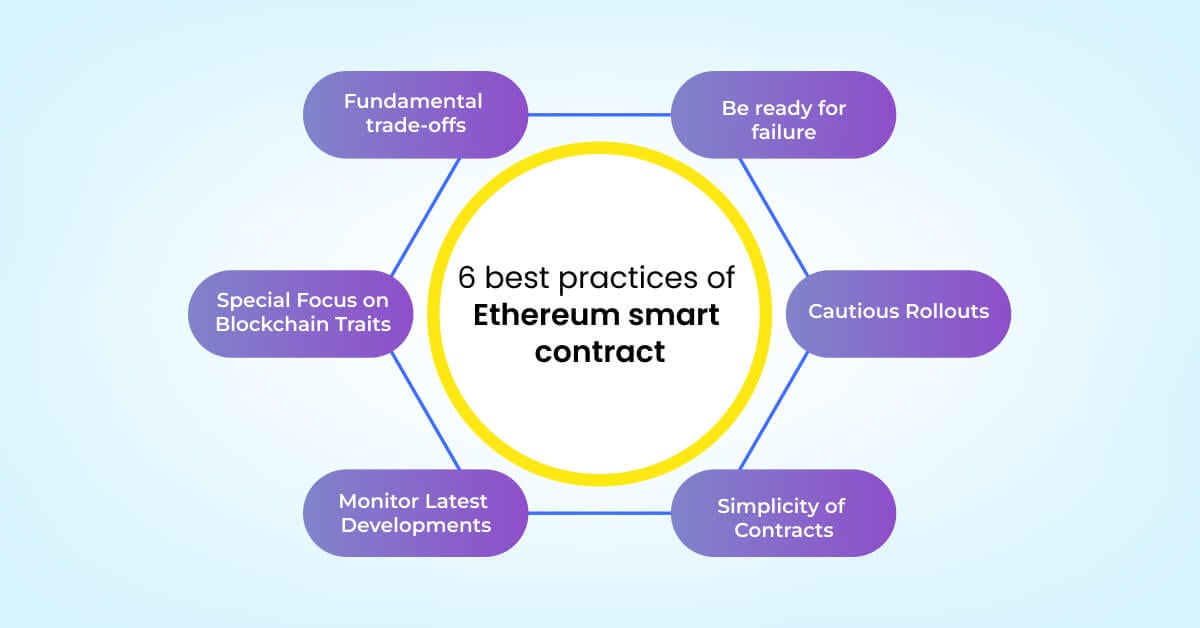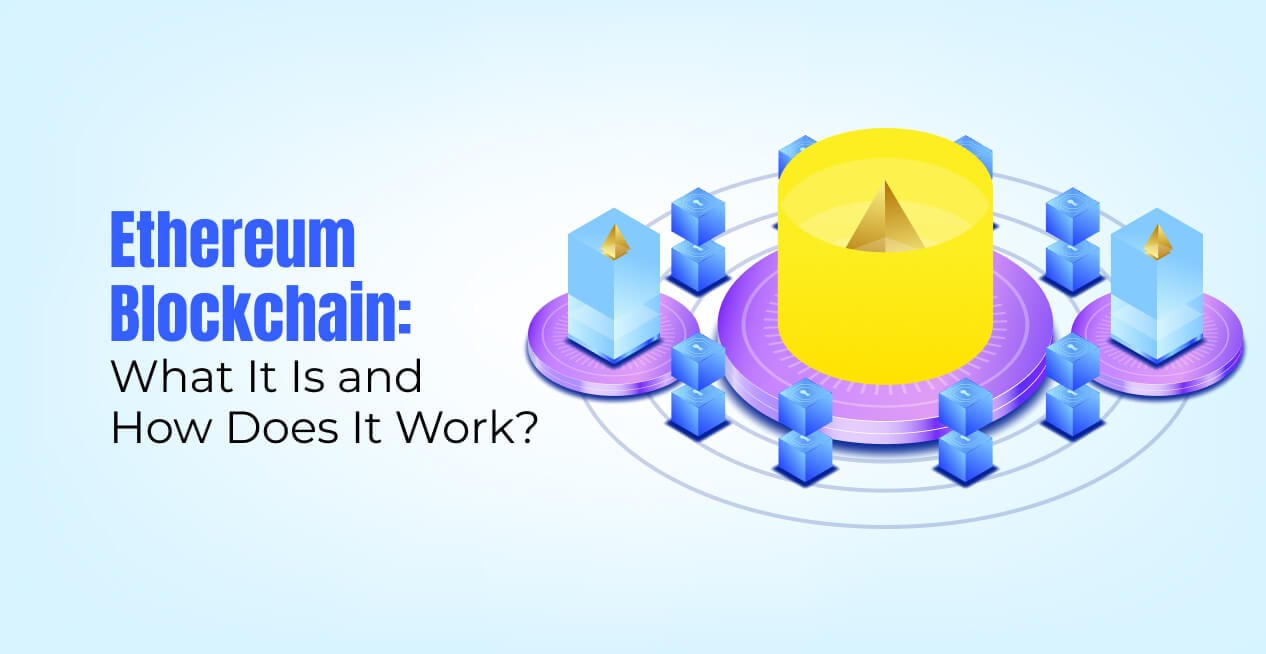-
Introduction:
-
Brief History of Ethereum
-
Ethereum definition
-
How does Ethereum work?
- Advantages of Ethereum
- Disadvantages of Ethereum
- The future of Ethereum
-
Ethereum Blockchain Development Company
- Brief idea about Ethereum Stack
- Responsibilities of Ethereum Developers
- 6 best practices of Ethereum smart contract
-
Hire our Ethereum blockchain developers for your business
Introduction:
Isn’t it a more digitalized world where the currency has also become digital? Ethereum is a type of cryptocurrency or a digital currency exclusively available online. It is amongst the most widely used cryptocurrencies and ranks second after Bitcoin, in terms of size (as of April 2022).
Cryptocurrency has sparked a lot of controversies, with some hailing it as the world’s next payment system and others seeing it as nothing more than a market bubble. Here in the blog is a brief synopsis of What Ethereum is and how does it operate?
Brief History of Ethereum
Vitalik Buterin developed Ethereum in 2013 to solve the constraints of Bitcoin by providing smart contracts, which enabled the development of decentralised applications (DApps). Ethereum 1.0 was founded as a community-driven network and was funded through a token presale. The Ethereum Foundation was established in Switzerland to ensure the development of the network; however, Buterin later transformed the foundation into a nonprofit, which caused some co-founders to leave.
In 2016, developers formed the Decentralized Autonomous Organization (DAO). It is a democratic body that decides on network proposals using a majority vote supported by smart contracts. However, an unknown hacker used a security flaw to steal $40 million from The DAO, which prompted Ethereum to “hard fork” and adopt a new protocol. It performed a significant software upgrade. (the original network still survives as Ethereum Classic).
Ethereum definition
Ethereum is a decentralized, open-source, blockchain-based platform that enables the creation of smart contracts and decentralized applications (DApps). It has its own cryptocurrency, Ether (ETH) which is used for transactions and computational services on the network. Ethereum was founded in 2014 by Vitalik Buterin and has grown to be one of the world’s largest and most widely used blockchain networks.
How does Ethereum work?
Ethereum operates with a copy of the Ethereum blockchain stored on each computer in a decentralized network. Building and deploying decentralized apps, or DApps, on the Ethereum blockchain is possible. These DApps are powered by smart contracts, which are self-executing contracts between a buyer and a seller that are directly encoded lines of code.
The platform accepts payment for the execution of these smart contracts and transaction fees using its own money, Ethereum. When a DApp or smart contract is executed, it requires computation power from the Ethereum network. This computation power is provided by the nodes in the network, which are incentivized by being paid in ETH.
Ethereum also enables the creation and deployment of decentralized autonomous organizations (DAO). It is an organization that runs through rules encoded as computer programs on a blockchain network.
Advantages of Ethereum
1. Decentralization
Ethereum’s decentralised architecture efficiently distributes information and trust among network users, removing the need for a centralised authority to oversee the entire operation and mediate transactions.
2. Rapid deployment
Organizations are swiftly developing and managing private blockchain networks utilising an all-in-one SaaS platform like Hyperledger Besu rather than creating a blockchain from scratch.
3. Permissioned network
Due to various open-source protocol layers, businesses are constructing public and private Ethereum networks, ensuring that their solution complies with all applicable security and legal requirements.
4. Network size
Ethereum proved that a network with millions of users and hundreds of nodes could operate. However, most commercial blockchain rivals run networks with less than ten nodes and need more experience to build an extensive and influential network. Network size is crucial for corporate partnerships bound to outgrow a few nodes.
5. Private transactions
By combining private partnerships with the private transaction in Ethereum, enterprises may get granular privacy control. Private information is given access through encryption and only shared with those who need to know.
6. Scalability and performance
Depending on the network configuration, Ethereum consortiums may outperform the public mainnet and reach hundreds of transactions per second or more. Proof of Authority Consensus, bespoke block times, and gas restrictions make this possible.
7. Finality
The consensus method of a blockchain ensures that the transaction record is tamper-proof and canonical. Ethereum offers customizable consensus mechanisms for different enterprise network instances, including RAFT and IBFT.
8. Tokenization
Any item that has been registered in a digital format can be tokenized on Ethereum. Organizations can increase their product line, open new incentive models, and fractionalize formerly monolithic assets by tokenizing their assets.
9. Interoperability and open source
Consortia on Ethereum are not locked into the IT environment of a single vendor. Like the Java community, the Ethereum ecosystem promotes codebase contributions through Ethereum Improvement Proposals (EIPs).
10. Standard
Ethereum is where the standards are. Protocols around token design (ERC20), human-readable names (ENS), decentralized storage (Swarm), and decentralized messaging (Whisper).
Disadvantages of Ethereum
1. Utilizes a difficult programming language
Ethereum uses programming languages like C++, Python, and Java, so learning Solidity, the platform’s native language, may be difficult.
2. Scaling problems
Ethereum has a ledger, a platform for smart contracts, and other features that could all result in mistakes, breakdowns, and hacks.
3. Ethereum investment can be risky
Ethereum investment might be risky, just like any other cryptocurrency. Due to high volatility, cryptocurrencies can see substantial profits and losses.
4. Higher Transaction Costs
Gas fees are bids within the Ethereum ecosystem for a set of transactions to be included in the limited block space. In situations of high demand, these bids increase as users try to expedite their transactions to gain an advantage. Transaction costs, as a result, are exceedingly expensive.
The future of Ethereum
The future of Ethereum is challenging to predict with certainty, as technology and cryptocurrency constantly keep evolving. The future of Ethereum is uncertain and subject to speculation. However, Ethereum has a large and active developer community, and its platform is widely recognized as a leading blockchain for developing decentralized applications. However, the following potential developments and trends could shape the future of Ethereum in 2023 and beyond:
1. Growth of DeFi (Decentralized Finance)
The DeFi ecosystem built on Ethereum has seen rapid growth in recent years, and this development is anticipated to continue in the years to come. More financial applications and services are being developed on the Ethereum network, increasing its utility and adoption.
2. Increased adoption of NFTs
The popularity of NFTs has grown significantly recently, and this trend is expected to continue. NFT producers and collectors prefer Ethereum because it supports NFTs via smart contracts.
3. Ethereum 2.0 Upgrade
The much-awaited Ethereum 2.0 upgrade would significantly enhance the Ethereum network, providing greater scalability, security, and sustainability. This would support Ethereum in maintaining its position as a leading platform for Decentralized applications.
4. Competition from other Blockchain platforms
Ethereum faces competition from other blockchain platforms, such as Binance Smart Chain and Polygon, which offers lower processing fees and faster processing times. However, Ethereum may have a competitive advantage over rivals due to its strong developer community, rich ecosystem, and track record.
Overall, the future of Ethereum is promising, and it will likely continue to play a significant role in the development and adoption of decentralized technologies in the years to come.
Ethereum Blockchain Development Company
Utilize the best-fitting suite of Ethereum blockchain development services at OpenXcell. Our comprehensive experience contributes to exploring, designing, and constructing a dynamic Ethereum ecosystem that is highly safe, scalable, and innovative. We are a leading blockchain development firm that creates bespoke dApps and smart contracts for:-
– Banking institutions
– Metaverse
– Supply chain
– DeFi Gaming, and many more
Do you want to scale your company to achieve sustainable development with minimal effort? Reach us at, www.openxcell.com
Brief idea about Ethereum Stack
The complete “Ethereum stack,” just like the software stack, varies from project to project based on the target objectives.
The Ethereum stack of technologies powers the Ethereum blockchain platform. It consists of several layers, each serving a particular function and combining to offer a comprehensive solution for developing decentralised applications. By comprehending those stack layers, you can better understand how Ethereum can be included in software projects.
Smart contracts
Smart contracts are executable programs that run on the Ethereum blockchain. It is written using specific programming languages that compile to EVM bytecode (low-level machine instruction called opcodes).
Smart contracts serve as open-source libraries, or rather, as always-available, unstoppable open API services. It enables public functionalities where users and apps (DApps) can communicate without restriction.
Ethereum virtual machine
The runtime environment in which decentralized apps and smart contracts are executed is called the EVM (Ethereum Virtual Machine). On the Ethereum blockchain, transactions carry out all smart contract executions and state modifications. The EVM handles all of the transaction processing on the Ethereum network.
Ethereum client APIS
You can connect to the Ethereum node and send a transaction to the blockchain using the Ethereum client API. A smart contract can be created and run using the Ethereum client. Different programming languages have produced a wide variety of client libraries.
End user applications
User-facing applications are at the top of the stack. These are the typical applications you create and use daily, primarily web and mobile apps.
The process of creating these user interfaces remains the same. Users frequently won’t need to be aware that a blockchain was used to build their application.
Ethereum nodes
Any computer running the required software to connect to the Ethereum network is considered an Ethereum node. Nodes connect to exchange information for validating transactions and store information about the blockchain’s current status.
Responsibilities of Ethereum Developers
Ethereum developers have a variety of responsibilities, including:
1. Creation, design, and implementation of Ethereum smart contracts
Smart contracts are self-executing contracts created, tested, and deployed by Ethereum developers. The contract conditions between the buyer and seller are directly encoded into these lines of code.
2. Building decentralized applications (DApps)
DApps, or programs built on the Ethereum network, are created and maintained by Ethereum developers. DApps can be used for various purposes, including social media, games, and financial services.
3. Maintaining network security
Ethereum developers are responsible for ensuring that the network is secure and that its protocols and smart contracts are not vulnerable to attacks.
4. Timely updating of the Ethereum network
Ethereum developers work on updating the Ethereum network to ensure scalability, effectiveness, and overall functionality.
5. Improving the user experience
The goal of the Ethereum developer is to simplify user interaction with the network, whether through the development of user-friendly wallets or more intuitive methods of interacting with smart contracts.
6. Collaborating with the Ethereum community
The large Ethereum community, which consists of users, researchers, and other developers, collaborates closely with Ethereum developers to identify problems, share expertise, and create new solutions.
The primary responsibility of an Ethereum developer is to constantly expand and improve the Ethereum network to make it more scalable, secure, and user-friendly.
6 best practices of Ethereum smart contract

When someone asks for the best practices of Ethereum you will no doubt mention the general practices of Smart Contracts. The best techniques are required to protect the smart contract from various shortcomings and bugs. The developers’ mindset primarily determines the general guidelines. Additionally, smart contract methodologies heavily influence the common yet best practices for Ethereum-based smart contracts. Here are a few common best practices one must watch out for;
1. Be ready for failure
No matter how odd it may sound, with smart contracts, you must always be ready for failure. One must be prepared to take on the responsibility of addressing smart contract difficulties and respond appropriately. For instance, you can halt the contract if unwarranted circumstances arise or develop a solid upgrade plan to help with problems and facilitate improvements.
2. Cautious Rollouts
The recommended practices for Ethereum smart contracts mention the necessity for prudence with rollouts. It is more likely that any flaws will be found and fixed before the production stage. You may guarantee cautious rollouts by thoroughly testing or implementing smart contracts in subsequent phases.
3. Simplicity of Contracts
The list of security recommends simplicity practices in the context of Ethereum smart contracts. Simple Ethereum smart contracts must be maintained with expectations for numerous prominent faults. Developers can keep simple, smart contracts by creating a simple contract logic. Developers can also experiment with other approaches, such as converting code into different modules. In addition to prioritizing transparency above performance, you may also use reusable code or tools.
4. Monitor Latest Developments
The Ethereum smart contracts outline the need to keep up with the most recent Ethereum advancements. The most recent improvements and modifications to Ethereum smart contracts’ basic infrastructure or security must be kept up to date by developers. For instance, developers must regularly examine smart contracts for bugs and errors. As a priority, developers must prepare to implement cutting-edge security methods in their smart contracts.
5. Special Focus on Blockchain Traits
Ethereum smart contract developers must know the key blockchain traits. For instance, the recommended practices for Ethereum smart contracts suggest using external calls with caution. Additionally, developers must consider the cost of gas, and block gas restrictions with the smart contract. Further, developers must take into account the possibility of inaccurate blockchain timestamps.
6. Fundamental trade-offs
The best practices for Ethereum smart contracts are the fundamental trade-offs. If you want security, you must compromise on the structure and vice versa. The trade-offs depend on your conditions, and you must always look for simplicity for better security assurance.
Hire our Ethereum blockchain developers for your business
We, at OpenXcell, are the leading Ethereum blockchain software development company in India and USA. Our focus is on giving global clients high-quality and enduring blockchain development solutions. Our team of professionals is the creators and bespoken blockchain services providers who continually endeavour to bring unique yet impeccable solutions to blockchain development.
We offer quality resources, such as a dedicated team of Ethereum blockchain developers who create a unique, scalable, and secure platform to suit the demands of consumers in numerous business verticals.










